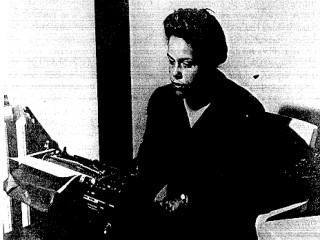
Gwendolyn Bennett biography
Date of birth : 1902-07-08
Date of death : 1981-05-30
Birthplace : Giddings, Texas
Nationality : American
Category : Famous Figures
Last modified : 2011-05-25
Credited as : Author, Harlem Circles, Epitaph Opportunity
2 votes so far
Gwendolyn B. Bennett was one of the prominent figures of the Harlem Renaissance. Her heritage is a main theme in her poetry. Her works reflected the shared themes and motifs of the Harlem Renaissance. Racial pride, rediscovery of Africa, recognition of African music and dance were common themes in Bennett's works.
Her column, The Ebony Flute, was Bennett's link to the Harlem cultural and social life. She used it to her advantage to network with other poets and to spread the news of the Renaissance. She would feature other writers' work and discuss them in her column. Although Bennett never published a collection of her own works and poetry, she was a strong influence on the Harlem Renaissance by giving the African American community racial pride. She also created a romantic vision of being African through romantic lyric.
Harlem Circles
During 1923 to 1931, Bennett started a support group that provided a warm, supportive place for the young writers of Harlem that provided sustained association with their peers. Included in this group were Langston Hughes, Countee Cullen, Eric Walrond, Helene Johnson, Wallace Thurman, Richard Bruce Nugent, Aaron Douglas, Alta Douglass, Rudolph Fisher and Zora Neale Hurston. The group was designed to motivate these young writers to support and encourage each other and were also, in turn, encouraged to aspire to the levels of more established scholars such as Charles S. Johnson, Alain Locke, W. E. B. Du Bois, Jessie Fauset, and James Weldon Johnson. Bennett said in a 1979 interview that, "nothing like this particular life in which you saw the same group of people over and over again. You were always glad to see them. You always had an exciting time when you were with them." This Harlem circle that Gwendolyn developed helped her sustain her steady connection with the Renaissance in New York throughout a period of her life.
Bennett faded from the public eye during the late-1940s but she remained close to the hub of busy Harlem in New York and her fellow writers. She began working for the Consumers Union during the later years of her life. Her retirement occurred in 1968 and moved with her husband, Crosscup, to Kutztown, Pennsylvania where they opened an antique shop. Her husband died in 1980, due to heart failure, and Bennett died on May 30, 1981 at the Reading County Hospital.
Short stories
1926 — Wedding Day Fire!!
1927 — Tokens Ebony & Topaz
Non-fiction
1926-1928 — "The Ebony Flute" (column) Opportunity
1924 — "The Future of the Negro in Art" Howard University Record (Dec)
1925 — "Negros: Inherent Craftsmen" Howard University Record (Feb)
1928 — "The American Negro Paints" Southern Workman (Jan)
1934 — "I go to Camp" Opportunity (Aug)
1934 — "Never the Twain Must Meet" Opportunity (Mar)
1935 — "Rounding the Century: Story of the Colored Orphan Asylum & Association for the Benefit of Colored Children in New York City" Crisis (June)
1937 — "The Harlem Artists Guild" Art Front (May)
Poetry
1923 — "Heritage" Opportunity (Dec)
1923 — "Nocturne" Crisis (Nov)
1924 — "To Usward" Crisis (May) and Opportunity (May)
1924 — "Wind" Opportunity (Nov)
1925 — "On a Birthday" Opportunity (Sept)
1925 — "Pugation" Opportunity (Feb)
1926 — "Song" Palms (Oct)
1926 — "Street Lamps in Early Spring" Opportunity (May)
1926 — "Lines Written At the Grave of Alexandre Dumas" Opportunity (July)
1926 — "Moon Tonight" Gypsy (Oct)
1926 — "Hatred" Opportunity (June)
1926 — "Dear Things" Palms (Oct)
1926 — "Dirge" Palms (Oct)
1934 — "Epitaph" Opportunity (Mar)
















